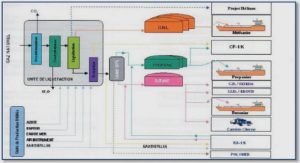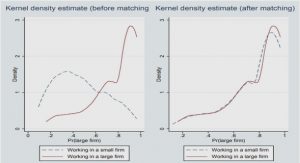Get Complete Project Material File(s) Now! »
CHAPTER 2 Growth and development of soybean and crown root nodules experiencing drought stress
ABSTRACT
Drought stress causes a severe decline in soybeans’ (Glycine max) symbiotic nitrogen fixation and yield. To possibly identify changes in gene regulation involved in the drought-induced senescence process through a gene expression profile analysis, a drought experiment, representative of drought in a natural environment, were designed to induce different levels of stress in a controlled environment. A potted drought trial with three levels of drought stress measured in vermiculite water content (VWC) at 60 %, 40 % and 30 % were conducted. Other than a decline in growth that could be visually observed, drought stress also led to reduced moisture content of leaves and shoots at 30 % VWC and roots at all the different levels of stress. The vegetative development of plants were also inhibited at 40 % and 30 % VWC. Crown root nodule numbers and water potential were only affected by severe drought stress at 30 % VWC. The function of nodules were negatively affected by drought visible as the colour change in nodules from an active fixating pink/red to an inactive greenish colour. Ureides accumulated in the nodules during early drought but the extent of the severe drought stress was efficient to inhibit ureide formation and accumulation in the nodules. It was concluded that the drought stress levels of 40 % and 30 % VWC were sufficient to initiate induced senescence as it showed physiological differences. The 60 % drought stress level is still a valuable level to add for gene induction studies.
INTRODUCTION
Climate predictions indicate that in the near future more frequent and severe weather conditions, with possible significant higher temperature and extended periods of drought, will be experienced (Zinta et al., 2014). World-wide more than 40 % of crop losses can be attributed to drought stress conditions (Manavalan et al., 2009). Changes in climatic conditions could also cause severe soybean yield losses (Ku et al., 2013; Daryanto et al., 2015).
Different growth parameters can be used to measure the effect of different levels of drought stress for example nodule number and water use efficiency of different organs (Fenta et al., 2011) as well as the vegetative growth development (Van Heerden et al., 2004). Water potential is a dependable performance indicator during drought stress studies which can give an indication of the plants’ drought tolerance and should be used as a selection indicator (Jongdee et al., 2002; Siddique et al., 2000). Extended periods of drought not only affects natural plant growth and development but also lower nodule water potential, decreases nitrogenase activity and ultimately affects nodule formation and life span (Fernandez-Luquen et al., 2008; Gil-Quintana et al,. 2015).
Drought has various effects on symbiotic nitrogen fixation (SNF) such as decreasing Rhizobia bacteria in the soil leading to an inhibition of nodule formation and leghemoglobin which is needed for oxygen supply to the simbiosome (Fenta et al., 2011). One product of SNF in temperate legumes like soybean plants is the nitrogenous compound known as ureides (allantoin and allantoate) (Márquez-García et al., 2015). These compounds are important signals in a plants’ stress response (Marino et al., 2007). Studies have documented both the accumulation of ureides in nodules (Sinclair and Serraj, 1995; Serraj et al., 1999) as well as a decrease in nodule ureide content (King and Purcell, 2005; Todd et al., 2006; Ladrera et al., 2007). It has been speculated that a decrease of nodule activity due to ureides inhibition can occur as a feedback mechanism from nodules, or directly from the shoots (Serraj et al. 2001).
The objective of this part of the study was to investigate the effect that different levels of drought stress had on different growth parameters of soybean plants and particularly on root nodules. Whether or not the levels of drought were sufficient was important before nodule transcriptome sequencing could continue to analyse gene expression profiles.
MATERIALS AND METHODS
Plant material and quantification of vegetative development
Soybean (Glycine max L.) seeds, cultivar: Prima 2000 (Pannar Seed, South Africa), were planted in pots (17.5 cm x 20 cm diameter) containing fine-grade vermiculite (Mandoval PC, South Africa). Individual seeds were each treated with 0.5 g of commercial Bradyrhizobium japonicum inoculum of the WB 74-1 strain (SoyGro Bio-Fertiliser Limited). Plants were grown under natural light conditions, extended with artificial metal-halide lights for up to a 13 hours photoperiod at 600 µmol m-2s-1 photosynthetically active radiations (PAR). The greenhouse temperature was set to 27 ᵒC/ 25 ᵒC day/night temperature and humidity was maintained at 60 %. Plants were watered twice a week with de-ionised water and once a week with a nitrogen-free Hoagland nutrient solution (Fenta et al., 2012). This watering regime stimulated optimum growth for root nodules responsible for symbiotic fixation (Van Heerden et al., 2007).
All plants were grown until they reached the same vegetative growth stage (plastochron index of 3.6) as described by (Erickson and Michelini, 1957), using 25 mm as the reference lamina length. The plastochron index was calculated as follows: Plastochron index = n + (logLn – logR)/(logLn – logLn+1), where n is the youngest trifoliate leaf which is longer than the reference value of R=25 mm counting acropetally from the cotyledonary node. Ln and Ln+1 are the lengths of the trifoliate leaves in mm of n and n+1. To produce less error, only the central pinna was measured from the base to the tip (Handa and Yong Son, 1974).
Thereafter drought stress was initiated by refraining from watering the plants. Pots, together with the vermiculite surface, were covered with a plastic bag to ensure that water loss only occurred through transpiration (Fig. 2.1). The vermiculite water content (VWC) was lowered to 60 %, 40 % and 30 % by withholding both water and Hoagland solution. The respective VWC was calculated as follows: VWC = (fresh mass-dry mass)/fresh mass) X 100. The dry mass used in each pot was 300 g of dry vermiculite. When the desired VWC (60 %, 40 % and 30 %) was reached, plants were kept at the desired VWC for five days before plants and nodules were harvested on the fifth day for further analysis. Each drought stress (DS) treatment had its own control, which will be called DNon-stressed (DNS) hereafter. Although this experimental design added an age-factor to the three treatments, it was considered the most realistic replication of a natural drought progression in the field. The ages of the plants at harvest were 56 days (60 % VWC), 67 days (40 % VWC) and 75 days (30 % VWC) after sowing.
Five plants’ organs (young leaves, old leaves, root tips, shoots crown and lateral nodules) (Fig. 2.2) were flash frozen with liquid nitrogen and six plants’ samples from all five organs from both harvests were used in the subsequent growth analysis. The two youngest trifoliates were used to represent young leaves and the remaining trifoliates were used to represent old leaves.
Moisture content
The fresh mass (FM) of the two youngest trifoliate leaves (not fully expanded), remaining trifoliate leaves, roots, shoots, crown and lateral nodules were determined by using a AB104-5 Mettler-Tolendo balance. The dry mass (DM) was then determined by drying all samples in an oven at 60 ºC for approximately 48 h until a constant mass were obtained. Fresh and dry mass can be seen in Appendix A, Tables A.1-2. The moisture content was then determined on a wet basis as follows: Moisture content = (Fresh mass-Dry mass)/Fresh mass X 100.
Nodule number, leaf and nodule water potential
Leaf water potential was determined using a pressure bomb (Model 3005 ITC International Australia), while crown nodules (nodules found on the tap root) water potential were determined using a WP4 Dew Point Potential meter (Decagon, USA).
Leaf water potential (ΨLeaf) was determined pre-dawn on the day of harvest using DS and DNS samples. The central pinna of the third trifoliate leaf counting acropetally from the cotyledonary node was used by placing the cut end of the stem protruding through the specimen holder. Nitrogen gas was then applied to the chamber until a droplet of sap could be observed on the stem (Fig. 2.3). The pressure that is required to produce a sap droplet is equivalent to the force of absorption and capillary with which water is held to plant tissue (Valenzuela-Vazquez et al., 1997).
Crown nodules were collected by hand and counted. Nodule water potential (ΨNod) was determined immediately after the harvest commenced at 09:00, using 0.1 g of crown nodules together with a WP4 Dew Point Potential meter (Decagon, USA) as described by Guerin et al.
Declaration
Acknowledgements
Summary
Thesis composition
List of Tables
List of Figures
Abbreviations and Symbols
CHAPTER 1
1.1 INTRODUCTION
1.1.1 Soybean and its significance
1.1.2 Root nodule development, physiology and function
1.1.3 Nodule senescence
1.1.4 Drought stress and drought tolerance
1.1.5 Cysteine proteases and inhibitors
1.1.5.1 Cysteine proteases
1.1.5.2 Papain-like (C1) cysteine proteases
1.1.5.3 Legumain-like (C13) cysteine protease
1.1.5.4 Nodule cysteine proteases
1.1.5.5 Cysteine protease inhibitors
1.2 PROBLEM STATEMENT
1.3 AIMS AND OBJECTIVE
CHAPTER 2
ABSTRACT
2.1 INTRODUCTION
2.2 MATERIALS AND METHODS
2.3 RESULTS
2.4 DISCUSSION
CHAPTER 3
ABSTRACT
3.1 INTRODUCTION
3.2 MATERIALS AND METHODS
3.3 RESULTS
3.4 DISCUSSION
CHAPTER 4
ABSTRACT
4.1 INTRODUCTION
4.2 MATERIALS AND METHOD
4.3 RESULTS
4.4 DISCUSSION
CHAPTER 5
ABSTRACT
5.1 INTRODUCTION
5.2 MATERIALS AND METHODS
5.3 RESULTS
5.4 DISCUSSION
CHAPTER 6
LITERATURE CITED
APPENDIXES
GET THE COMPLETE PROJECT






